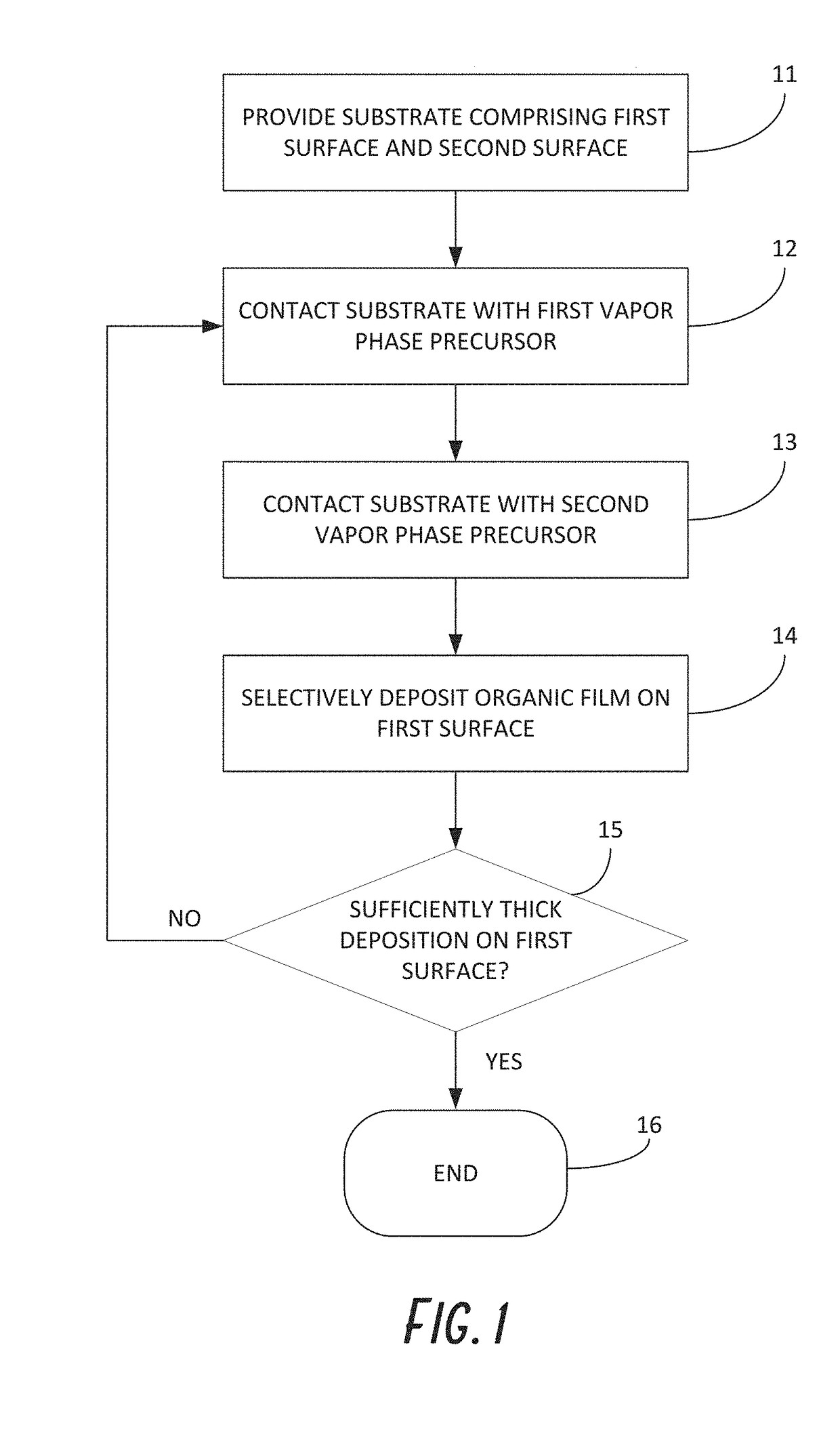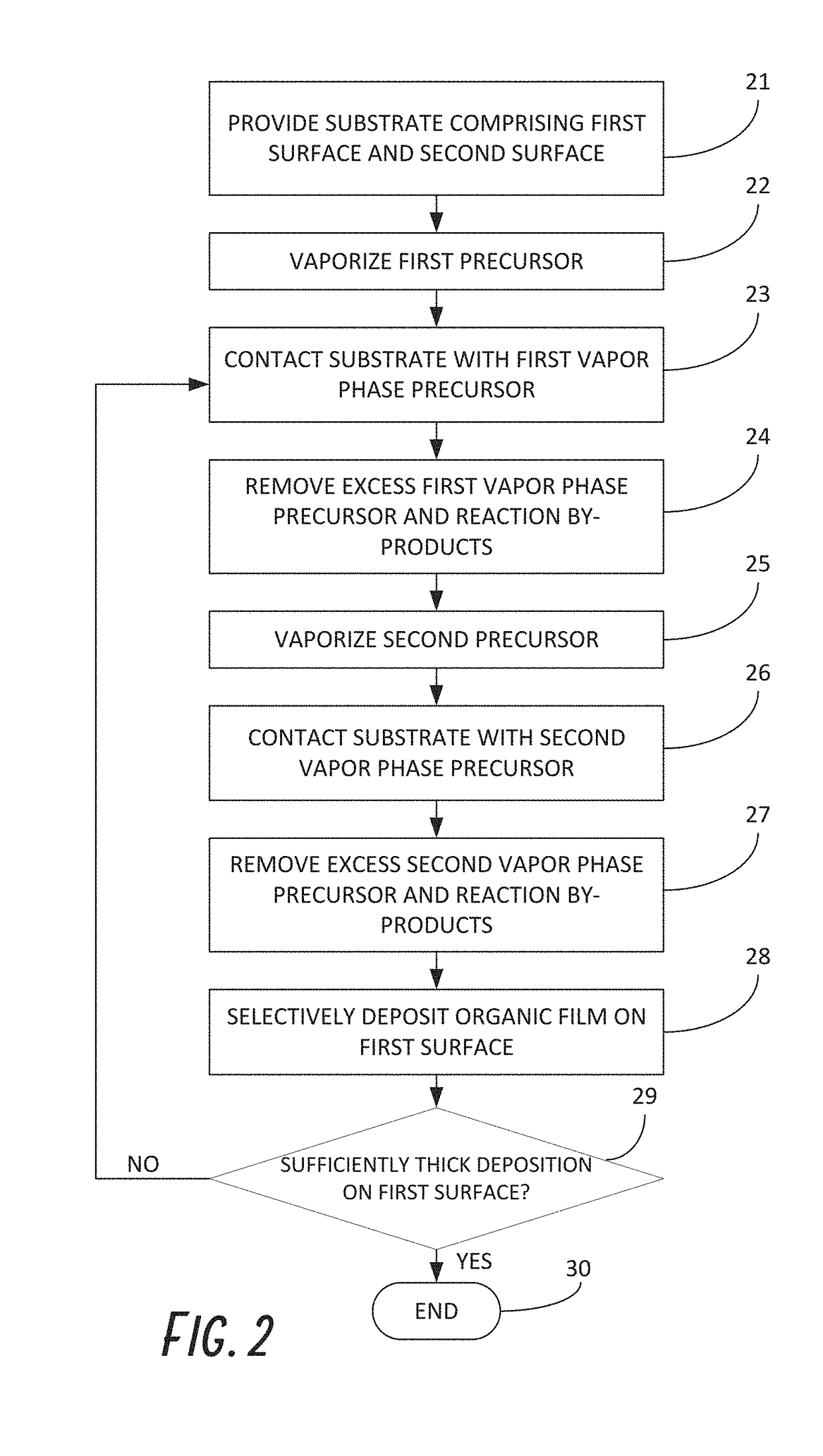Deposition of organic films
a thin film, organic technology, applied in the direction of coatings, chemical vapor deposition coatings, metallic material coating processes, etc., can solve the problems of difficult to fill gaps of very small features, and difficult control of thin film formation on a substrate. , to achieve the effect of increasing the resistance to hf etch
- Summary
- Abstract
- Description
- Claims
- Application Information
AI Technical Summary
Benefits of technology
Problems solved by technology
Method used
Image
Examples
example 1
[0166]Sample polyimide thin films were deposited on a number of substrates according to selective deposition processes described herein. 200 mm silicon wafers having tungsten (W) features alternated with silicon oxide surfaces were used as substrates. The width of the tungsten features was 250 nm with a pitch of approximately 600 nm. The polyimide deposition processes were performed in a Pulsar 3000® cross-flow ALD reactor connected with PRI cluster tool.
[0167]A first batch of sample polyimide films were deposited according to the processes described herein using DAH as a first vapor phase reactant and PMDA as a second vapor phase reactant. The DAH first reactant was supplied at 45° C. by an N2 carrier gas having a flow rate of 450 sccm. The DAH pulse time was 5 seconds and the DAH pure time was 4 seconds. The PMDA second reactant was supplied to the reaction chamber at 180° C. by an N2 carrier gas having a flow rate of 450 sccm. The PMDA pulse time was 11 seconds and the PMDA purge...
example 2
[0171]A first sample polyamide film was deposited on a 200 mm silicon wafer having patterned tungsten (W) features alternated with silicon oxide surfaces. A second sample polyamide film was deposited on a crystalline silicon wafer having 1.5 nm of native oxide. The samples were deposited according to the processes described herein using adipoyl chloride (AC) as a first vapor phase reactant and ethylene diamine (EDA) as a second vapor phase reactant. The AC first reactant was vaporized at a temperature of 50° C. and supplied to the reaction chamber at a temperature of 65° C. with a line flow of 500 sccm. The AC pulse and purge times were 2.5 seconds. A pulsing pressure of about 180 Torr was used and the conduit through which the AC was supplied was fitted with a line filter. The ED second reactant was supplied at room temperature with pulse and purge times of ⅕ seconds. A pulsing pressure of about 100 Torr was used and the conduit through which the ED was supplied was not fitted with...
example 3
[0174]A sample polyimide film was selectively deposited on a 200 mm silicon wafer having patterned tungsten (W) features alternated with silicon oxide surfaces according to the processes described herein using DAH as a first vapor phase reactant and PMDA as a second vapor phase reactant. The DAH first reactant was supplied at 45° C. by an N2 carrier gas having a flow rate of 450 sccm. The DAH pulse time was 5 seconds and the DAH pure time was 4 seconds. The PIVIDA second reactant was supplied to the reaction chamber at 180° C. by an N2 carrier gas having a flow rate of 450 sccm. The PMDA pulse time was 11 seconds and the PMDA purge time was 4 seconds. The reaction temperature was 190° C. The polyimide sample film was deposited using 1000 deposition cycles. The polyimide was deposited on the W surface, with a film thickness of about 30 nm. A substantially lesser amount of polyimide was deposited on the silicon oxide surface, about 4 nm, as shown in FIG. 10A.
[0175]The sample polyimide...
PUM
| Property | Measurement | Unit |
|---|---|---|
| Thickness | aaaaa | aaaaa |
| Dielectric polarization enthalpy | aaaaa | aaaaa |
| Electrical resistance | aaaaa | aaaaa |
Abstract
Description
Claims
Application Information
 Login to View More
Login to View More - R&D
- Intellectual Property
- Life Sciences
- Materials
- Tech Scout
- Unparalleled Data Quality
- Higher Quality Content
- 60% Fewer Hallucinations
Browse by: Latest US Patents, China's latest patents, Technical Efficacy Thesaurus, Application Domain, Technology Topic, Popular Technical Reports.
© 2025 PatSnap. All rights reserved.Legal|Privacy policy|Modern Slavery Act Transparency Statement|Sitemap|About US| Contact US: help@patsnap.com



